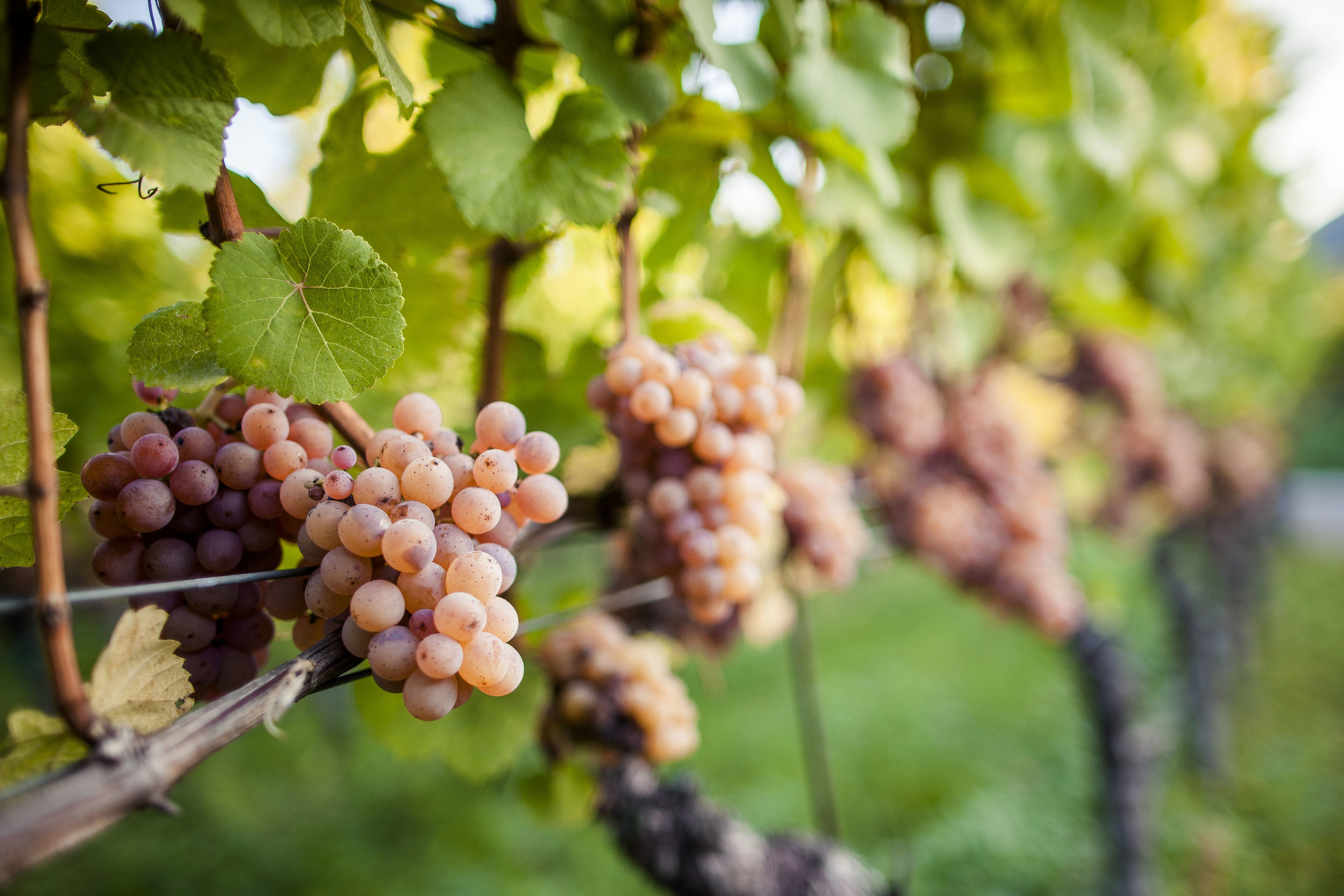Give Gewurztraminer a Chance
Gewürztraminer grapes growing in Suditrol, Alto Adige, photo by IDM - Florian Andergassen
It’s not all heady perfume, sticky sweetness, and burning alcohol; restrained, balanced Gewürztraminers offer complexity and charm.
Gewürztraminer is a polarizing grape variety. Slightly tongue-twisting (geh-VURTZ-trah-mee-ner) and supremely distinctive, it’s tough to miss in a blind tasting. Pungent, perfumed aromas jump from the glass, a potpourri-like melange of rose petals, lychee, orange marmalade, ginger, and honey. This intense, aromatic, perfumey character, which often carries through to the palate, is what makes some people love Gewürztraminer and others hate it. But while it’s easy to toss this bombastic grape variety aside, vintners all over the world are making well-balanced, restrained versions of it. For a taste of the unique and intriguing in a solid winter white wine, give Gewürztraminer another try.
Alsace Rosacker Grand Cru_Riquewihr, Copyright ZVARDON-Conseil Vins Alsace
Gewürztraminer can easily push a wine drinker towards palate fatigue from too much richness and not enough refreshment. However, planted in the right areas and picked at the right times, Gewürztraminer can retain more acidity, which will balance fuller body and flavors, and steer clear of sky-high alcohol levels that soar above 14.5 percent. Certain techniques in the vineyard and the cellar can also restrain the intensity of the grape’s aromatics. Studies show that terpenes, which give the wines their strong floral bouquet, increase when vines are leaf-thinned and left to ripen for too long. Shadier Gewürztraminer grapes picked sooner might have more aromatic and structural balance. Exposing the wines to oxygen during fermentation and aging can bring out even more depth of perfume.
Even on the vine, Gewürztraminer makes a statement. Its deeply pink-hued berries typically create a golden-colored wine, often tinted with tones of copper or rose gold. It is a structural oddball as well, as the grape’s tendency to amass bucketloads of sugar usually translates to residual sweetness, high alcohol, or both. Combined with the variety’s low acidity, also calm Gewürztraminer’s aromas.
A mutation of Traminer, legend has it that Gewürztraminer originated near the town of Tramin in northern Italy’s Alto Adige region. More likely, Gewürztraminer hails from northeastern France or Germany, but the general climates of all three of these areas – cool, continental, sunny – speaks to the conditions in which the grape thrives. Alsace remains the most famous region for Gewurztraminer (the umlaut is not used in France and is a style preference from other producers), where sun-soaked vineyards ripen grapes fully, creating rich, concentrated wines that often have a touch – or a heavy dose – of sweetness. While Austria and Germany both plant Gewürztraminer, the Alto Adige region probably ranks second behind Alsace in terms of enthusiasm for the grape and number of high-quality examples, which are more often dry. A smattering of vines exist elsewhere in the Old World, and in the New World, vintners in California, Washington, New York, and New Zealand have all begun working with Gewürztraminer grapes, finding success in cooler regions.
As more winemakers work with Gewürztraminer, the overall quality of the wines continues to rise. Yes, there are restrained versions out there, wines that are as pleasant when sipped solo as they are when paired with spicy dishes – one of the quintessential pairings of off-dry Gewürztraminer. Or try one with the hearty, herb-rubbed meat roasts that become more prevalent as temperatures cool. Skeptics should look for these six international bottles in order to give Gewürztraminer another chance.
Gewürztraminers to Try:
Gustave Lorentz Gewurztraminer Reserve 2016, Alsace, France ($23)
Subtly fragrant on the nose, with notes of Pink Lady apple and fresh lemon juice, this Alsatian Gewürztraminer is pleasantly refreshing, with a touch of sugar.
Domaine Ostertag Gewurztraminer 2015, Alsace, France ($31)
This biodynamic wine exudes lush, exotic fruit on both nose and palate but avoids the perfume that some wine drinkers shy away from. Though it has sugar, zesty, citrus-like acidity curbs the wine’s sweetness, as does the distinct texture of the palate.
Castelfeder ‘Vom Lehm’ Gewürztraminer 2017, Alto Adige, Italy ($18)
courtesy Suditrol official travel site
Harmonious notes of peach, lavender, and earth weave together to create an impactful bouquet that stops short of being overwhelming. It is juicy on the palate, with a clean finish.
Cantina Colterenzio Gewürztraminer 2016, Alto Adige, Italy ($20)
All of the classic indicators for Gewürztraminer are here – nectarine, lilac perfume, exotic spice – but the fragrance is subtle. The off-dry palate is spicier, but it leads into a fresh finish.
Golan Heights Winery Yarden Gewurztraminer 2017, Galilee, Israel ($20)
Though this juicy Israeli Gewürztraminer has concentration and complexity, it isn’t pungently aromatic. Think sharp orange zest combined with strawberry and rose scents, along with a hefty dose of spicy peppercorn.
Dr. Konstantin Frank Gewürztraminer 2016, Finger Lakes, New York ($17)
Balanced and easy-drinking, this is a lighter style of Gewürztraminer. Citrus notes of orange and lemon carry the fruit profile, accented by soft tones of rose petals, ginger, and honey.



